
Bronze-age petroglyphs at Boglösa, Uppland.
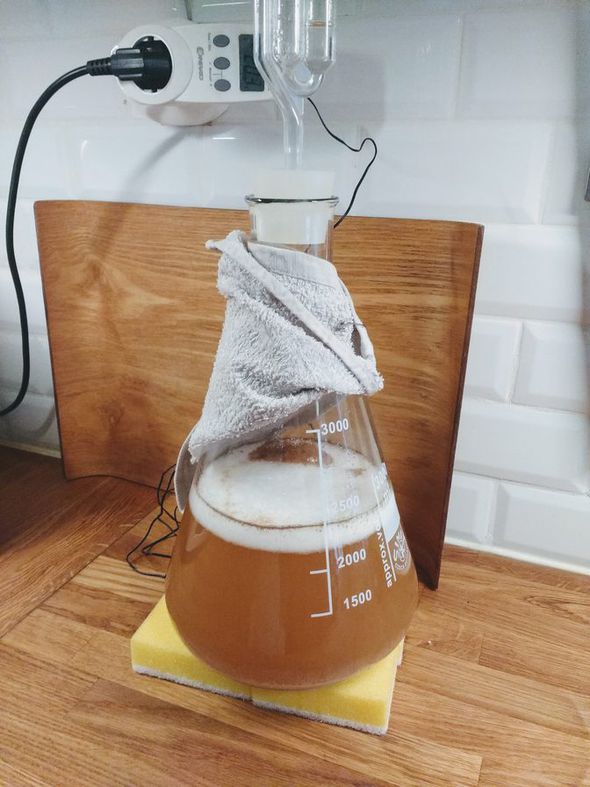
Isn't it a beauty? The picture does not fully convey its size, but this 3 liter Erlenmeyer flask is an impressive piece of glass. Yes, as you can see I've taken another step deeper into the homebrewing pit and have been making yeast starters for the last three batches of beer. This is to multiply the number of yeast cells in advance, in order to achieve the optimal "pitching rate" for good fermentation.
Shown in the picture is the starter for our #13 Weißbier which turned out fantastic, exactly to my taste. A light and fruity summer beer, topping our previous wheat beer, and many of the ones you can buy, if I may say so myself. Naturally, it is all gone by now.
Following up on the last brewing post, I have to correct something I wrote there. The #11 Bockbier was a disappointment after all. It had a very strong buttery taste, coming from diacetyl which in turn resuls from poor fermentation. The strong wort got far too few yeast cells, so they did not manage to clean up this unwanted byproduct. Now I know better.
Then there was a technical mishap. I had the brilliant idea to get some cool air from my beer fridge into the fermentation box beside it, to regulate the temperature better. So I drilled a large hole into the fridge wall to place a ventilation fan there. But I did not know that modern fridges' cooling lines run within the side walls as well, so I accidentally cut one off, effectively destroying the fridge. Luckily, used fridges are cheap and I have gotten another one meanwhile. Another lesson learned.
On to more joyous things; while I write these lines, I am having a glass of our #14 Stout which I think is quite a success. Subtle roast and chocolate aromas, not overdone; black as night, fittingly low carbonation, and tasting mature already two weeks after tapping to bottles.
Still in the fermentor is the #15 Dunkles, a dark lager in typical Munich style. I will bottle it this week-end and brew the next batch at the same time, #16 YAPA. The Erlenmeyer's airlock is bubbling away already.
Bonus picture: When cooking the Stout, I maxed out the 30 liter pot, filling it to the brim.
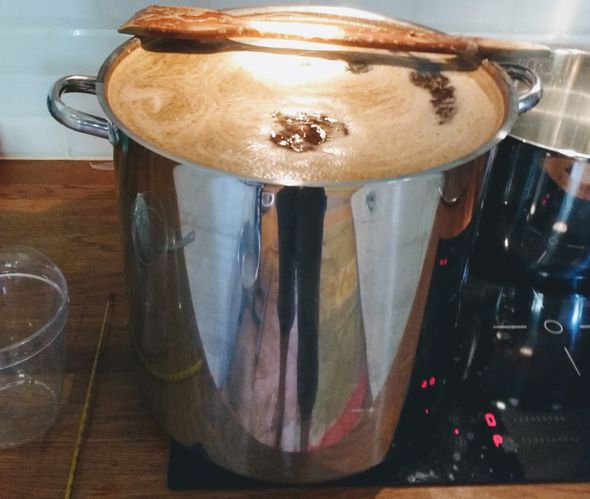
Following up on my previous post about homebrewing beer, it is about time to mention batches #8 to #12 that we've been making since March. As before I'll link below to the GoogleDocs that we use for keeping logs.
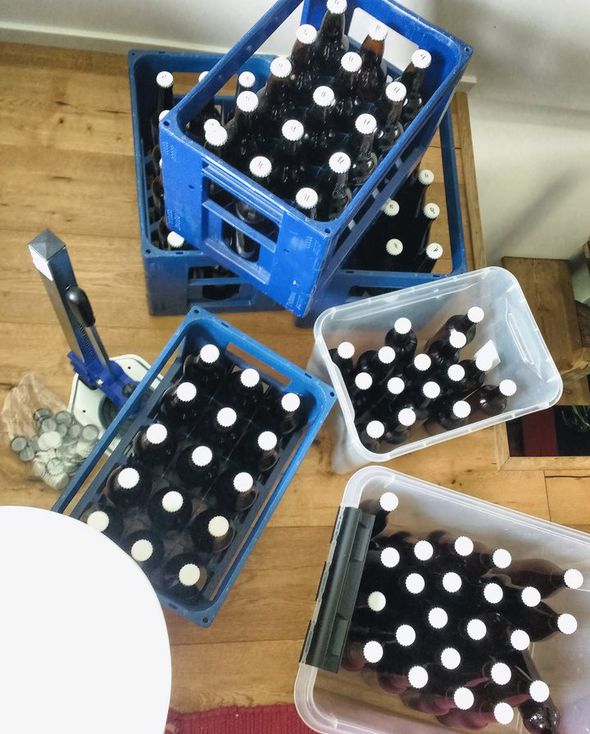
But first let me mention the most important thing I've learned since that last post: water adjustment. Looking at the analysis from our own deep well I found a good explanation for why our light-colored beers had a harsh and unpleasant bitterness to them; turns out that our water has a high rest alkalinity, causing a too high ph-value of the mash which in turn causes this astringency. The best compact explanation and adjustment calulator I've found so far is this one, in German though. The link has our water values pre-filled, so you can easily see that we would have needed to add 7ml of lactic acid to the mash water to compensate the alkalinity for a Pilsner like our #5.
When it comes to equipment I've only made a few minor improvements, like lautering into a newly-bought 3l-beaker instead of the boiling pot. This shortens the time until boil because the heat can be on as soon as the first beaker is emptied into the pot on the stove. It also eliminates the critical moment of liftig the full pot up onto the stove - dropping it, or one of the handles to break off would result in 27 liters of sugar solution being spread all over the kitchen floor, not a pleasant thought. On the other hand, we now have to be careful to not let the beaker run full; yeas, it has happened once already.
I am also more than halfway into reading J. Palmer's How to Brew which I bought recently. It nicely summarizes what I had learned so far from various sources, it explains the why behind certain rules and practices, and generally goes into much more detail than I had expected from an all-encompassing book. Highly recommended!
Finally, the beers:
The #7 Copper Cascade Lager already mentioned last time turned out very good. Red and dark-ish, it was nicely malty and lacked the astringency of the ligher beers before. In hindsight this is as expected, since darker malts work better with alkaline water.
The #8 Weißbier was fantastic, my favourite so far. When poured without the yeast from the bottle it was perfectly clear (Kristallweizen), and very pleasant and easy to drink. Which meant it did not last long...
#9 A&K Festbier was a light Ale after a recipe that matched more or less the ingredients that I had left. It turned out nicely, perfectly drinkable, but not spectacular.
The #10 Blonde was a failure in the sense that I wanted to re-make the Weißbier from above, but messed up when ordering ingredients online; I thus had no wheat malt. But the WLP300 yeast needed to be used so I improvised the malt mixture. Recipe-wise it somewhat matches a light Belgian ale but the yeast made a "Weißbier" out of it anyway, with a clear resemblance to #8, but quite not as good. Still surprisingly drinkable.
#11 Bockbier was the birthday present to myself, trying out a stronger beer for once (OG 1.062, 6.8% vol.alc.), in the style of a light-colored German Bock. This was bottled almost two weeks ago and I just tried the first one this evening, prompting me to write this post. Because it is amazingly good! Very pleasant, not astringent (water adjustment seems to work), and hiding its high alcohol content well - the kind of stuff that is dangerous! In the sense that it is all too easy to have one too much of. I'll give the other bottles a few more days of conditioning before they go into the fridge.
#12 IPA. Finally, we also gave in to the trend and made an India Pale Ale, first time dry-hopping from day 8 to 12. I bottled it today (see picture above, together with #11) and it will stay at room-temperature for a little less than two weeks, as usual. Report on how it turned out will follow.
The next two batches are most likely to be a dark Lager (Münchner Dunkles) and a proper re-creation of the #8 Weißbier. This time with yeast starters to have the proper pitching rate of yeast cells - many of the previous beers had a too-low amount of yeast added in the beginning, according to Palmer's wisdom.
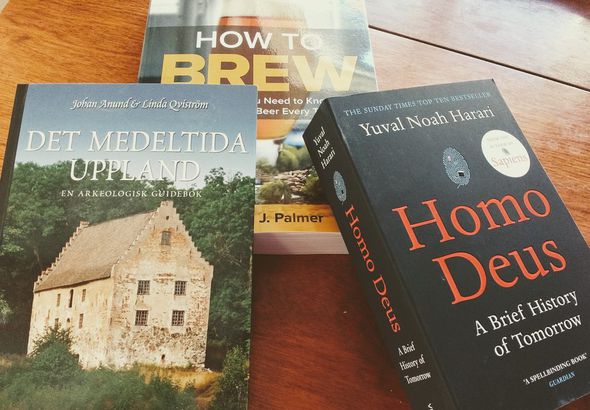
It's not often that I treat myself with a fresh order of books - I've been consuming more ebooks and audiobooks lately. But after I finished Harari's fantastic Sapiens, I wanted the successor Homo Deus right away. If you havn't heard of the former, I can highly recommend it! It's a critical look at our species, from a more unbiased perspective than we are used to.
Then there is Medieval Uppland, a book that will hopefully give us some inspiration for summer excursions nearby. Last, How To Brew is the just-out new edition of what seems to be the homebrewers' bible. After skimming through it, there sure is enough detail to satisfy the needs of not-so-novice-anymore brewers. I'm currently waiting for my 11th batch to finish fermenting.

I finally managed to fix our sewing machine, so what was started when it broke could be finished. Never mind that the very cold days are over.
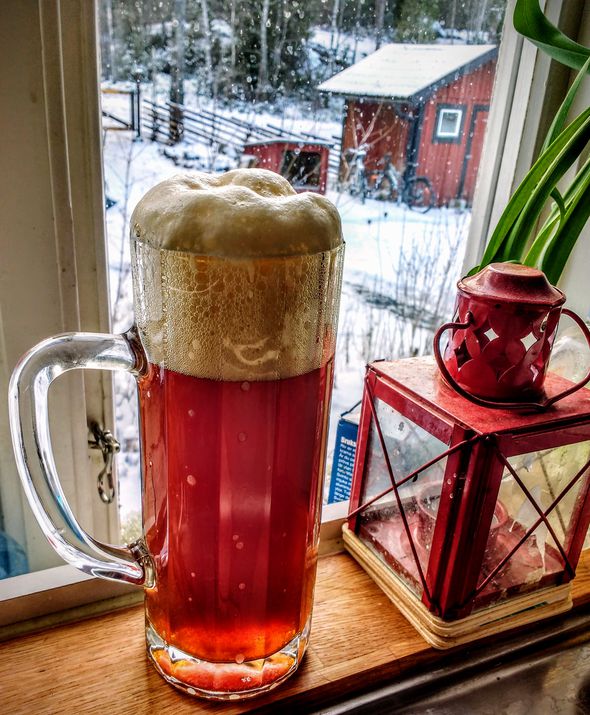
In November last year, two colleagues and I happened to talk over lunch about home-brewing beer; a few days later packages with equipment arrived at our door-steps. None of us had any real experience and I only vaguely remembered a good podcast (CRE 194, in German) on the subject. But how hard could it be?
So we read a few websites and ended up following the beginner's instructions at brauanleitung.de. Our equipment is for the standard homebrewers' batch size of ~20 liters (5 gallons), meaning a big pot, two plastic buckets, one for filtration, one for fermenting; a few hoses and connectors, plus the actual ingredients for our batch #1: a single hop and single (Pilsner) malt for a German-style "Altbier", that is a light ale like they were made before Lagers became popular.
The result was good. Not the most amazing beer ever (partly because we were impatient and did not give it enough time from bottle fermentation to drinking), but definitely good enough to continue! I will link below to the GoogleDocs that we used for keeping our logs; these are in a varying mix of three languages (Swe/Ger/Eng) since we all know them to some degree and gathered recipes and information this way. But fellow brewers should be possible to read the recipes anyway.
Our #2 was an Irish Red Ale. This was a big step up, following a proper recipe with four times as many ingredients as our #1. We thought it would fit nicely as a Christmas beer, and it sure did. Very malty, not much hops, almost sweet because of the liquid yeast with lower attenuation.
The Brown Ale #3 came into being through me just taking some remaining ingredients from the previous two batches. It turned out quite all right, more bitter and hoppy than #2, less malty.
Next we wanted to try a Lager, since our closet in wintertime holds a temperature of 10-12 C, perfect for bottom-fermentation. So #4 became a Helles, that is a Munich-style light lager and it went really well. Clear, great color and taste, better than the average commercial Helles I tried at the time in Munich.
Continuing in the same line, our #5 is a Pilsner. Quite happy with that one as well, on the upper end of hop and bitterness for my liking, but far from any of the trendy IPAs that go berserk on the hops. The dry yeast settled better in the bottle than the one we had for #4, so it it easier to pour clear into the glass.
For #6 we went for a Dark Ale that has some torrefied maize among the ingredients. It makes for a fantastic foam, but maybe we overdid the carbonation a little because it foams by itself when opening a bottle, and the sediment gets torn up and mixed. Fortunately it settles quickly in the glass after pouring. Another very pleasant malty ale!
#7 is Copper Cascade, another Lager, reddish this time, probably the last for this winter. This batch is about to be bottled, so no verdict on the outcome yet.
Overall the above means that I now have a little stash at home to enjoy whenever I feel like it, which is very luxurious. We have some routine in brewing and bottling now, no screw-ups yet, it is still fun and considering Swedish prices on beer, our small investment in the beginning has already more than paid for itself. We will therefore continue, maybe at a slightly slower pace than recently. Next in line are a Bavarian wheat beer and an IPA. The malts and hops are already on the way.